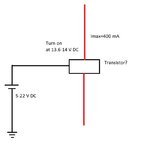jsmith24
Newbie level 6
Hi all,
I'm setting up a small solar panel to act as a trickle charger for a small 12V SLA battery. I've stepped down the 22 volt max from the 1.5 watt solar panel to 13.5 volts with a buck converter, with a maximum current of about 250 mA, but when the solar panel outputs less than 13.5 volts, the buck converter starts drawing power from the battery I want charged. I tried simply placing a diode after the buck converter, but there is still reverse leakage current. What I'd like to do is have the circuit after the buck come on ONLY when the voltage coming INTO the buck exceeds 13.5 volts or so. I know that charge controllers are available, but a 1.5 watt panel doesn't output enough to drive a controller AND charge a battery.
So, I think it can be done with a transistor, I'm just foggy - been out of the game for way too long. Can anyone take my simple diagram and show me some magic? The simpler, the better!
The simpler, the better!
Thanks,
Jack

I'm setting up a small solar panel to act as a trickle charger for a small 12V SLA battery. I've stepped down the 22 volt max from the 1.5 watt solar panel to 13.5 volts with a buck converter, with a maximum current of about 250 mA, but when the solar panel outputs less than 13.5 volts, the buck converter starts drawing power from the battery I want charged. I tried simply placing a diode after the buck converter, but there is still reverse leakage current. What I'd like to do is have the circuit after the buck come on ONLY when the voltage coming INTO the buck exceeds 13.5 volts or so. I know that charge controllers are available, but a 1.5 watt panel doesn't output enough to drive a controller AND charge a battery.
So, I think it can be done with a transistor, I'm just foggy - been out of the game for way too long. Can anyone take my simple diagram and show me some magic?
Thanks,
Jack
